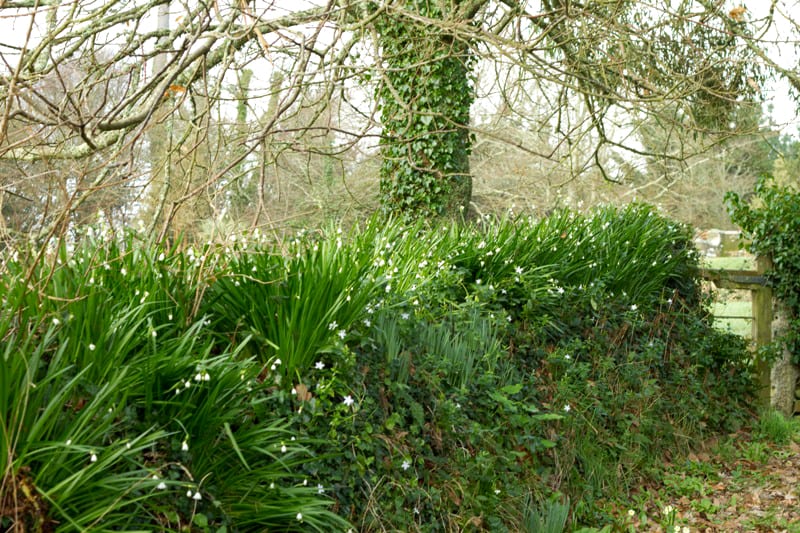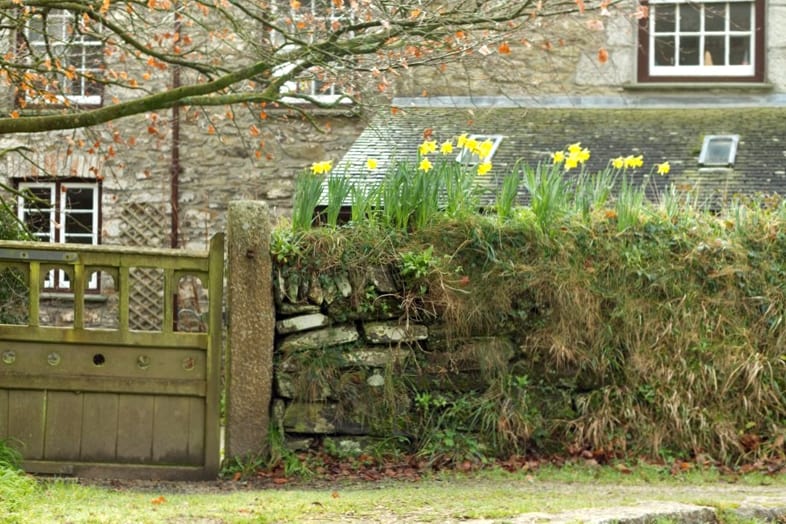Have you ever considered adding plants not just to the base of your stone walls – but on them and in them? Greening up the rock walls in your garden with some pocket planting into the walls will give your garden a more established, stately, rustic, and natural look. Inspired by these images by Concha over at Saidos da Concha (taken of garden walls in Cornwall, England) – I’ve pulled together some ideas for what types of plants and bubs you can grow to add life and greenery to your stone walls.
Stone walls with plants growing on them
Particularly in the USA, I think we have this tendency to be overly concerned with keeping things pristine and new. In other parts of the world, it is common to see less-than-perfect and more time-worn stone walls and garden structures. We tend to find them beautiful and scenic, but we fail to realize that we can emulate them by encouraging a less-than-perfect aesthetic in our own gardens.

While new is nice, there is also a place for rustic natural stone walls with enough dirt on them that you can plant your bulbs on top of or on the sides of the walls rather than just in the ground beneath. This faux wabi-sabi can be built into the design of the wall.
I really liked the way the Cornish people plant bulbs on top of walls – everything looks natural and centuries-old.

Considerations for Planting into a stone wall
Make sure you pay attention to the direction of the wall. A south (or Sun facing wall) will be considerably warmer (than even a south facing bed). You may be able to stretch your hardiness zone around stone walls due to the stone acting as a protective and moderating influence in the immediate microclimate. North facing walls also create microclimates. The plants get less sun, but overall they are less impacted by the extremes of temperature.
The best way to figure out what will work or not is to try a few marginal plants and see if, by planting them near or on a stone wall, they survive. I have a thriving collection of alestromeria in my garden whose success is due to it’s close proximity to a north facing wall.
Your wall building materials may have an influence on the soil pH. If your wall is made with alkaline mortar of limestone then you might struggle with acid-loving perennials and plants.
Galanthus and daffodils (pictured) are great small bulbs for tucking into pockets of soil. You can experiment with others like scilla or chiondaxa. None of these are, however, native to North American landscapes.
As for perennials and annuals, Other considerations include considering the stone of your wall. If your stone wall is made of alkaline mortar or limestone, then you might struggle with acid-loving perennials.
North American Native Plants for Stone Walls
There are many options for plants that grow on stone walls – Fine Gardening has a great list of ideas here. But if you are looking for plants that are native to North America – here’s a list of options. Some are better suited for sun or shade, so check your choices against the direction of your wall and the situation of your stones.
Blunt-lobed Woodsia (Woodsia obtusa). Blunt-lobed Woodsia is a fern with delicate, finely divided fronds. It’s a small fern often found in rocky habitats. Native to: North America, Zones 3-8.
Columbine (Aquilegia spp.). Columbines have unique, spurred flowers in various colors. They have delicate foliage and are attractive to pollinators. Some varieties are native to North America others are from Europe, and Asia. Zone 3-9.
Moss Pink (Phlox subulata). – Moss Pink is a low-growing perennial with small, pink, lavender, or white flowers that cover the ground like a carpet. Hardiness Zone: Zones 2-9
Mosses – Native mosses like Haircap Moss (Polytrichum spp.) and Rockcap Moss (Dicranum spp.) can naturally cover stone surfaces, adding a lush, green appearance.
Virginia Bluebell (Mertensia virginica). – While typically found in woodland settings, Virginia bluebells can thrive in pockets of soil between stones, providing a burst of spring color.
Virginia Spring Beauty (Claytonia virginica) – A charming native wildflower found in eastern North America. This perennial plant produces delicate, five-petaled pink or white flowers in early spring. It often carpets woodlands and meadows with its dainty blooms. Zones 3-8.
Sedum spp. (Stonecrop). – Various sedum species, such as Sedum ternatum and Sedum acre (which is actually native to Greenland), are excellent for rock gardens and stone walls due to their drought tolerance and low-growing habits.
Armeria maritima (Sea Thrift). – Sea thrift is a compact perennial with pink or white flowers that adapts well to rocky or sandy conditions.
Campanula rotundifolia (Harebell) – Harebell produces delicate, bell-shaped blue flowers and can grow in rocky or well-drained soil.
Alpine Strawberry (Fragaria vesca) – Alpine strawberries produce small, edible fruits and can spread in rocky areas.
Hepatica spp. (Liverwort) – Liverworts are native wildflowers that can grow in crevices between stones, displaying charming, early spring blooms.
Pussytoes (Antennaria spp.) – Pussytoes are low-growing perennials with silvery foliage and dainty, fuzzy flowers that adapt to rocky environments.
Wild Ginger (Asarum spp.) – Wild ginger is a ground cover plant with heart-shaped leaves that can thrive in shaded, rocky areas.
(photos: Tiago Cabral )
Climate and plant choices will have much to do with any individual success with this.
Do a bit of research. I’m not sure daffs would survive on a wall like this in my Michigan zone 5 garden…
This wall is very pretty.
I’m doing a two foot high retaining wall, forty feet long, and I would love to have dry stacked battered fieldstone. It would have been perfect for the drainage too, with natural weepholes, and I’m sure moss and some other things would have volunteered on it. Violets honeysuckle and onion grass at least. But the budget monster shoved us back to cast cement, which is much too regular in shape and color. I feel like stone costs more because of demand – it can’t be that much more labor or materials.
So maybe if I train some honeysuckle or trumpet over part of it, it wont be so bad. And some crocus on top. Maybe build in a pocket for liriope, or even some ferns. I guess anything that can manage between the knots of tree root back there will grow some in a wall pocket.
In my climate, nothing remains pristine for long. In warm weather Lantana trails over huge chunks of limestone that delinate the right of way in front of my house. In winter I cut back dead stems just enough to allow daffodils to come up through, adding the chopped tan bits to pinestraw mulch. Annuals follow, then perennials and shrubs with the return of Lantana for a colorful summer and fall. Do what works where you plant.
I agree. It certainly adds softness to the wall.